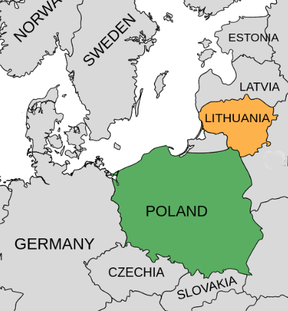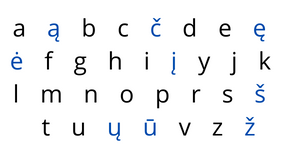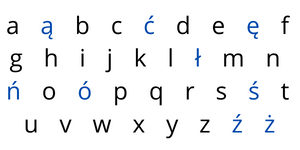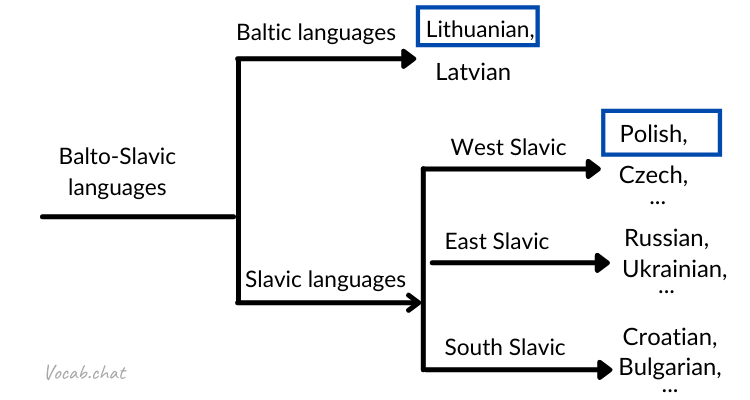Lithuanian and Polish [Language Similarities]
Lithuania and Poland are neighboring countries that share a border. You can even travel by train from Warsaw (the capital of Poland) to Vilnius (the capital of Lithuania).
The geographical proximity of Lithuania and Poland makes people ask if their languages —Lithuanian and Polish— are similar.

Polish and Lithuanian are both Indo-European languages. This language family, however, is quite large: it includes most of the official languages within the European Union (except a few, such as Finnish, Hungarian, Estonian, and Maltese); it also includes languages like Persian, Russian, and Hindi.
So, being part of the Indo-European language family ensures only a very minimal level of similarity between Polish and Lithuanian.
Indeed, as it turns out, Polish and Lithuanian belong to different branches within the Indo-European language family.
Polish is a West Slavic language; it is, therefore, more closely related to languages from that branch, such as Czech and Slovak, than to Lithuanian.
Lithuanian, on the other hand, is a Baltic language; this means that Lithuanian is more closely related to Latvian (another Baltic language) than to Polish.
Lithuanian alphabet vs. Polish alphabet
Polish and Lithuanian have in common the use of the Latin alphabet, and both languages have some additional letters which are not found in English.
The Lithuanian alphabet The Polish alphabet
The Polish alphabet

One similarity between the Lithuanian and the Polish alphabet is the use of the ogonek, which is a hook placed below the lower right corner of a vowel.
While Polish uses this mark under two letters (ą, ę), Lithuanian has 4 letters that use this mark (ą, ę, į, ų).
Originally Lithuanian and Polish were similar in their use of the ogonek: in both languages, it indicated nasalized vowels. But in the 18th century, this changed: the ogonek became used in Lithuanian to indicate long vowels, while in Polish it still indicates nasalized vowels.
Lithuanian distinguishes long and short vowels, whereas Polish doesn’t.
Lithuanian has letters which have a caron, also known as a “háček”: (č, š, ž). The Lithuanian language borrowed these letters from Czech.
The letter ‘w’ is very common in Polish vocabulary words, but it is not part of the Lithuanian alphabet. In fact, 25% of the 1000 most common Polish words contain the letter ‘w’.
Here are some examples of Polish words which contain the letter ‘w’:
- Wysoki (tall)
- Słowo (word)
- Powiedzieć (to say)
- Ponownie (again)
- Również (also)
The letter ‘v’ does not appear in Polish vocabulary words (although it can appear in foreign words). In contrast, the letter ‘v’ is relatively common in Lithuanian vocabulary words. In fact, 12.5% of the 1000 most common Lithuanian words contain the letter ‘v’.
Here are some examples of Lithuanian words which contain the letter ‘v’:
- Vienas (one)
- Kiekvienas (each)
- Šviesa (light)
- Viršuje (above)
- Žuvis (fish)
The letters ‘q’ and ‘x’ are neither used in Polish nor in Lithuanian vocabulary words. These letters are however sometimes included in the Polish alphabet to accommodate foreign words.
A historical link with linguistic implications
Lithuania and Poland became linked in 1386 when Lithuania's Grand Duke Jogaila married the Polish queen Jadwiga. This led to a full union of Lithuania and Poland which lasted several centuries until 1795.
This historical connection led to an increase in the influence that the Polish language and the Lithuanian language had over each other.
Lithuanian and Polish: language families
Lithuanian and Polish are both part of the Indo-European family of languages. But so are most of the languages that are spoken in Europe (some notable exceptions include Estonian and Finnish as well as Hungarian).
The Indo-European family of languages is divided into several branches. There is the branch of Romance languages (French, Spanish, .. ), the branch of Germanic languages (English, German, ..), the branch of Balto-Slavic languages, and a few other branches.
Polish and Lithuanian both belong to the branch of Balto-Slavic languages. This branch is further subdivided into the Slavic branch (which includes Polish) and the Baltic branch (which includes Lithuanian)

Looking at the similarity between Polish and Lithuanian, we see that they are related - but only moderately.
Polish is more closely related to Czech than it is to Lithuanian. And Lithuanian is closer to Latvian than it is to Polish.
Lithuanian vs Polish vocabulary words
For most common vocabulary words, there are not many similarities between Lithuanian and Polish.
| English | Lithuanian | Polish |
|---|---|---|
| love | meilė | kocham |
| freedom | laisvė | wolność |
| truth | tiesa | prawda |
| language | kalba | język |
| moon | mėnulis | księżyc |
| beautiful | graži | piękny |
| book | knyga | książka |
| fish | žuvis | ryba |
| boat | valtis | łódź |
| friend | draugas | przyjaciel |
Lithuanian is one of the most conservative European languages. According to linguists, Lithuanian is the language still spoken today which has conserved most features from the Proto-Indo-European language.
Consonant clusters are harder in Polish than in Lithuanian
Polish is a language that is known for having consonant clusters which are difficult for non-native speakers to pronounce. Here are some examples:
- chrząszcz (meaning “beetle”)
- brzęczeć (meaning “buzz”)
Large consonant clusters are less common (and less difficult) in Lithuanian, compared to Polish.
Polish vs. Lithuanian: grammatical similarities & differences
Dropping pronouns in Polish vs. Lithuanian
Polish is a pro-drop language, which means that personal pronouns can often be omitted when they can be inferred from the context.
Lithuanian is a moderately pro-drop language, which means that this occurs as well (but less often than in Polish).
Spanish for instance is a well-known pro-drop language. In Spanish, the phrase “I love you” is typically worded as “Te quiero” (and not “Yo te quiero”).
The following example shows this same phrase in Polish and Lithuanian:
| English | I love you |
|---|---|
| Lithuanian | Kocham cię |
| Kocham cię | Aš tave myliu |
The pronoun is omitted from the Polish phrase, while it is present in the Lithuanian phrase.
Grammatical cases in Polish and Lithuanian
Polish and Lithuanian are similar in their heavy use of grammatical cases. This makes them difficult languages for English speakers to learn.
Lithuanian and Polish both have several grammatical cases:
- The nominative case corresponds to the subject of the sentence
- The accusative case corresponds to the direct object of a transitive verb
- The dative case corresponds to the recipient of an action
We will use these 3 in the examples below, but these are not the only ones. Lithuanian and Polish also have the genitive case, the instrumental case, the locative case, and the vocative case.
In Lithuanian and Polish, the endings of nouns change depending on the grammatical case. In these languages, the dictionary form of a noun will not necessarily be the form that the noun has when used in a sentence.
Here are some examples that show how Lithuanian and Polish nouns are inflected according to the grammatical case when used in sentences:
| Nominative: | |
| English | a cat plays |
|---|---|
| Lithuanian | katė žaidžia |
| Polish | kot się bawi |
| Accusative: | |
| English | I see a cat |
| Lithuanian | Matau katę |
| Polish | Widzę kota |
| Dative: | |
| English | I give food to a cat |
| Lithuanian | Aš duodu maistą katei |
| Polish | Daję kotu jedzenie |
There are several declension patterns in Lithuanian and Polish depending on the noun’s gender and its ending.
Lithuanian has 2 grammatical genders for Lithuanian nouns: masculine and feminine. There are 3 grammatical genders for Polish nouns: masculine, feminine, and neuter.
Another thing visible in the examples above is the absence of grammatical articles in both Lithuanian and Polish.
As a reminder, Grammatical articles are those frequently used words in English (the, a, an).
ConclusionThere are approximately 3 million native speakers of Lithuanian and 45 million native speakers of Polish. Both Lithuanian and Polish are among the official languages of the European Union.
Polish and Lithuanian are not mutually intelligible. This means that a Polish speaker (with no prior knowledge of Lithuanian) will not be able to understand Lithuanian (and vice versa).
To continue learning about the similarities and differences between Lithuanian and Polish, have a look at these lists of the 1000 most common Lithuanian words, and the 1000 most common Polish words.
References:- [1] (Map license)